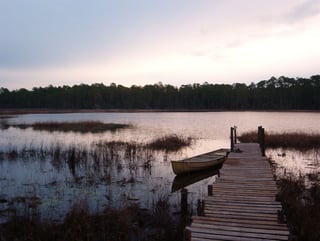
The St. Johns River (Spanish: Río San Juan) is the longest river in the U.S. state of Florida and its most significant one for commercial and recreational use. At 310 miles (500 km) long, it flows north and winds through or borders twelve counties. The drop in elevation from headwaters to mouth is less than 30 feet (9 m); like most Florida waterways, the St. Johns has a very slow flow speed of 0.3 mph (0.13 m/s), and is often described as "lazy". Numerous lakes are formed by the river or flow into it, but as a river its widest point is nearly 3 miles (5 km) across. The narrowest point is in the headwaters, an unnavigable marsh in Indian River County. The St. Johns drainage basin of 8,840 square miles (22,900 km2) includes some of Florida's major wetlands. It is separated into three major basins and two associated watersheds for Lake George and the Ocklawaha River, all managed by the St. Johns River Water Management District. Although Florida was the location of the first permanent European settlement in what would become the United States, much of Florida remained an undeveloped frontier into the 20th century. With the growth of population, the St. Johns, like many Florida rivers, was altered to make way for agricultural and residential centers, suffering severe pollution and redirection that has diminished its ecosystem. The St. Johns, named one of 14 American Heritage Rivers in 1998, was number 6 on a list of America's Ten Most Endangered Rivers in 2008. Restoration efforts are underway for the basins around the St. Johns as Florida's population continues to increase. Historically, a variety of people have lived on or near the St. Johns, including Paleo-indians, Archaic people, Timucua, Mocama, French, Spanish, and British colonists, Seminoles, slaves and freemen, Florida crackers, land developers, tourists and retirees. It has been the subject of William Bartram's journals, Harriet Beecher Stowe's letters home, and Marjorie Kinnan Rawlings' books. In the year 2000, 3.5 million people lived within the various watersheds that feed into the St. Johns River. From Wikipedia
